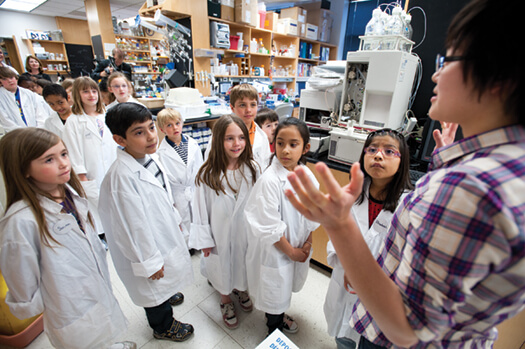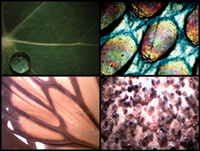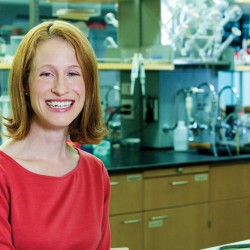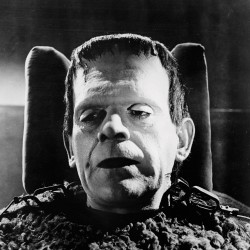Adventures in a Tiny Universe
A creative partnership brings youthful enthusiasm to the scientific method.

Researchers in the making listen intently as graduate student Jenna Eun ’07, PhDx’12 introduces them to Professor Doug Weibel’s research lab in the Biochemistry Building.
Troy Dassler’s fifteen third-graders, lab coated and goggled, are set to embark on their next adventure in the microverse.
Primed by their teacher, the eight- and nine-year-olds from Madison’s Leopold Elementary School break into small groups, pop open their laptops, hook up their digital optical microscopes, and begin to take careful notes about the world of the very small. Today’s objects of ocular inquiry are feathers: duck feathers, pheasant feathers, and a feather of undetermined origin, dyed to look like an eagle’s plume.
“Most black feathers are iridescent,” whispers Molly Jetzer, a fourth-grader who is serving, essentially, as Dassler’s teaching assistant for MicroExplorers, an after-school program intended to open up the microscopic universe to young students in the Madison Metropolitan School District. Feathers are also “superhydrophobic,” Dassler’s students are quick to add, slipping into lab jargon to explain why feathers so easily repel water.
MicroExplorers is the product of a broad UW-Madison collaboration. Inspiration for the program comes from biochemistry Professor Doug Weibel, a kid at heart, who thinks that every child should have a digital optical microscope and be as adept at using it as they are doing battle with aliens on a Wii.
“The microscope is timeless,” explains Weibel, who has partnered with UW-Madison’s Materials Research Science and Engineering Center and the Center for Biology Education to get microscopes into the hands of children. “We’re all visual learners. If you can see something, it’s easier to teach. Seeing reinforces ideas.”
The new, inexpensive generation of microscope has no eyepiece, but instead is tethered to a laptop computer. Images appear on the screen, and the MicroExplorers can snap digital still images or make movies. Four of the microscopes, each the size and shape of a large can of beans, are deployed in Dassler’s Leopold Elementary classroom. Teams of students crowd around the computer to view, describe, and characterize different objects, including such serendipitous offerings as the shed skin of Coco the gecko, Dassler’s classroom mascot.
With a microscope, says Weibel, “You can hit chemistry. You can hit physics. You can hit materials science.” The program, he contends, does far more than simply acquaint young people with the visual wonders of microscopy: it serves as a gateway to teaching the scientific method early on. Dassler’s students, for example, keep notebooks and have learned to make the distinction between observation and opinion.
The program’s biggest goal, says Weibel, is to establish an organized network of MicroExplorers in classrooms and after-school programs around the country.
“It’s a bootstrap operation now,” he notes. “In a year, we can work with about a thousand kids [from Madison schools], but we’d like to have a much bigger footprint.”

The third-graders — participants in the MicroExplorers after-school program — used microscopes to view details smaller than the eye can see. Care to guess what they were looking at? Click the photo for the answers. Good luck! Photo Courtesy of Troy Dassler/Microexplorers
The program will indeed grow next year, says Dassler, who spends his summers on the UW-Madison campus as part of the Research Experiences for Teachers program, funded by the National Science Foundation, which is part of the UW’s Materials Research Science and Engineering Center (MRSEC). He says the program will add another teacher in 2011, more than doubling its effect in the Madison area.
“What is really special about the program with the microscopes and the computers is that the students are using technology as researchers,” says Dassler. “They don’t use the technology to learn about how to use the technology. They use the technology to study the microscopic world and collect data.”
Greta Zenner Petersen MA’03, director of education for MRSEC, is no stranger to innovative science education programs. She sees MicroExplorers as the new wave in these efforts, pushing science and technology learning to ever-younger students.
“This is a new frontier,” says Zenner Petersen. “There is a push to get kids hooked at a younger age, but we have to meet them at their level. This program is fantastically successful at what it does.”
Published in the Fall 2010 issue



Comments
Gene Roma August 31, 2010
A wonderful program. Keep up the good work. I know these kids shared a great new world.
Janet Hewitt December 9, 2010
I am a computer lab teacher at Manatee Elementary in Melbourne Florida (The Space Coast). I would love to get my hands on one of these to be able to collaborate with core curriculum teahers K-6, I see about 900 students each week.